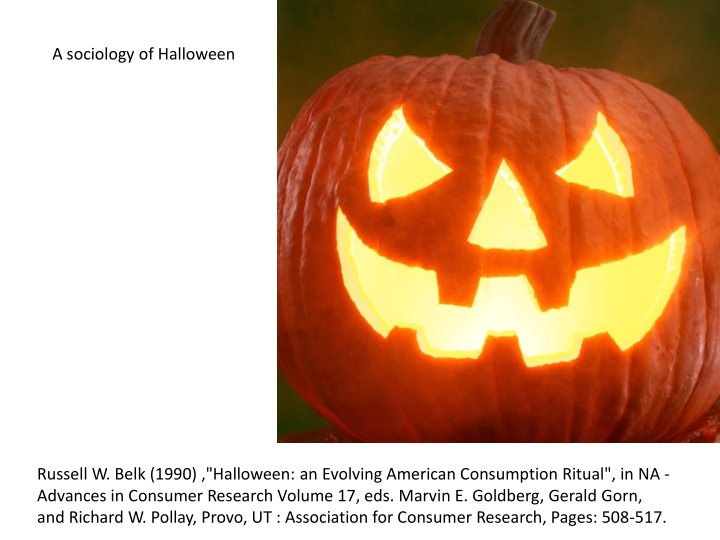



A sociology of Halloween Russell W. Belk (1990) ,"Halloween: an Evolving American Consumption Ritual", in NA - Advances in Consumer Research Volume 17, eds. Marvin E. Goldberg, Gerald Gorn, and Richard W. Pollay, Provo, UT : Association for Consumer Research, Pages: 508-517.
The origins of Halloween can be traced to Celtic celebrations of Samhain which was an observation of the harvest as well as the Celtic New Year’s festival Neolithic onwards Fires Feasts Ghosts Start of year End of year Traditionally, it is celebrated from 31 October to 1 November, as the Celtic day began and ended at sunset. This is about halfway between the autumn equinox and the winter solstice. It is one of the four Gaelic seasonal festivals,
Halloween was known by American colonists, but wasn't celebrated in the United States until after 1840 when the great Irish potato famine resulted in a large number of Irish immigrants (Santino 1983). Some of the Halloween games of the Irish such as bobbing for apples have survived, while others such as roasting nuts and fortune telling have largely disappeared Persistence, emergence, circulation
One funny day…. Halloween is a symbolic time to upset the social frameworks that define the other 355 days of the year and let out into the open closeted fears in a carnival atmosphere. Bahktin defined the “carnival” atmosphere of holidays as “temporary liberation from prevailing truth and from the established order that marked the suspension of all hierarchical rank, privileges, and norms…” This is why our behavior is so counter normative on Halloween; there is a loss of the established order that defines the rest of the year.
Order, disorder and fear What makes things scary Tonight's the night the ghosts and ghouls come out, and fear stalks the land. But why do we feel the need to be scared? Because horror reflects the fears not just of individuals, but of societies, argues Anne Billson https://www.theguardian.com/film/2008/oct/ 31/horror
Collective experience Émile Durkheim observed that rituals are occasions upon which people in a culture or society come together to reaffirm their values, beliefs, and morals. By participating in rituals together, we activate and reaffirm our "collective conscience"--the sum of those beliefs and ideas we share in common, that take on a life and force of their own due to their collective nature. In celebration of Halloween, those rituals include dressing in costume, trick-or-treating, throwing and attending costume parties, decorating homes, and going to haunted houses. This raises the question of what values, beliefs, and morals are reaffirmed through our mass participation in these rituals.
How ‘experience’ is made, marketed, shared and commercialized. From children to adults.. Gender.. What are people actually wearing Sex differences were prominent. Females were much more likely to be dressed as a witch/wizard, an inanimate object (e.g., pumpkin, pizza, doll, star) or as a stereotypical female role character (e.g., nurse, Snow White, harem girl, cheerleader, ballerina). Males were much more likely to be dressed as a superhero- (e.g., Superman, Batman), monster (e.g., Dracula, Freddy Krueger, zombie), a stereotypical male role character (e.g., hobo, sports player, cowboy), or as a scary animal (e.g., dragon, lion, leopard).
2018: Halloween spending to reach $9 billion Total spending for Halloween is expected to reach $9 billion this year. Celebrants are planning to spend an average of $86.79, up from last year’s $86.13, with more than 175 million Americans planning to partake in Halloween festivities. https://nrf.com/resources/consumer-research- and-data/holiday-spending/halloween- headquarters
Recommend
More recommend